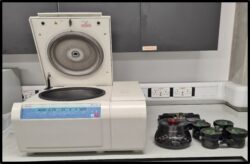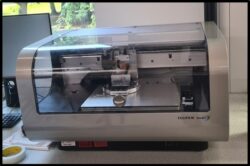Chemistry Research Facility
The Chemistry facilities within the MNP Research Group offer specialized resources for molecular and nanoscale research, reflecting our commitment to cutting-edge interdisciplinary exploration. For instance, our molecular synthesis labs and dedicated spaces for biochemical studies support research in areas like drug development, environmental chemistry, and nanotechnology. These facilities are meticulously maintained to ensure a controlled, safe, and efficient environment for complex experiments.
The labs also serve as a hands-on learning space for students, who benefit from training on professional-grade equipment, guided by expert faculty and technical staff. Additionally, dedicated laboratory managers and safety officers are present to maintain strict adherence to safety protocols and provide essential training, ensuring that all users are well-prepared to work within these dynamic environments.
Overall, the chemistry facilities at MNP research group reflect a robust commitment to fostering both educational and research excellence, providing a collaborative and inspiring space for scientific discovery.
Inside the Chem Lab
Explore some of our cutting-edge instruments, designed to support advanced research and detailed analysis. Each instrument is selected to enhance hands-on-learning and innovative discovery.
Fume Hoods - Clean Air-BS EN 14175 and CLEAPSS G9-6mm thick toughened glass sash
 Fume hoods (Clean Air-BS EN 14175 and CLEAPSS G9-6mm thick toughened glass sash) are the primary and most effective control measure for managing exposure to hazardous substances produced during experiments, such as gases, vapours, aerosols and dust.
Fume hoods (Clean Air-BS EN 14175 and CLEAPSS G9-6mm thick toughened glass sash) are the primary and most effective control measure for managing exposure to hazardous substances produced during experiments, such as gases, vapours, aerosols and dust.
They are strategically set up for specialized applications in our labs;
Lipid Drying: A dedicated fume hood equipped with a nitrogen gas supply and multiple outlets allows for rapid and efficient drying of different or identical samples, supporting streamlined workflows.
Acid Cleaning: A specially designated fume hood is reserved for acid cleaning processes, including Aqua Regia (used for dissolving gold nanoparticles and cleaning glassware) and Piranha cleaning/etching (a mixture of sulfuric acid and hydrogen peroxide) used for removing organic residues.
This setup ensures that both standard and specialized procedures are conducted with the highest safety standards, reducing the risk of contamination and enhancing efficiency.
Heraeus MEGAFUGE 16R benchtop Centrifuge (Thermo Scientific)
 The Heraeus MEGAFUGE 16R (Thermo Scientific) is a versatile, high performance benchtop centrifuge designed to meet the rigorous demands of modern laboratories. This compact yet powerful centrifuge is ideal for a wide range of applications in fields such as clinical, pharmaceutical, biotechnology, and academic research.
The Heraeus MEGAFUGE 16R (Thermo Scientific) is a versatile, high performance benchtop centrifuge designed to meet the rigorous demands of modern laboratories. This compact yet powerful centrifuge is ideal for a wide range of applications in fields such as clinical, pharmaceutical, biotechnology, and academic research.
Key features include:
Rotor Options: Heraeus Megafuge can accommodates various rotor options and tube size, allowing users to process up to 4.0 litres per run. Fixed-Angle Rotor (Thermo Scientific FIBERLITE F15-6x100y, 15000 rpm, 24700 x g) is ideal for faster separation and small sample volumes. Swing-Out Rotor (Thermo Scientific TX-400 4x400 mL, Swinging Bucket Rotor 75003655 Max load 570 g, Max speed 5000rpm, Max 5000 cycles and M-20 Microplate Rotor (Thermo Scientific 75003624, Max load 2x770 g, Max speed 4000 rpm, Max 5000 cycles) support large-volume and high throughput applications.
Advanced Safety Features: Equipped with a robust safety lid locking system, imbalance detection, and rotor recognition to protect both samples and users during operation.
User Friendly Interface: Features an intuitive digital control panel with customizable programs, enabling users to set parameters quickly and accurately.
Efficient Cooling System: Ensures that samples are maintained at the desired temperature throughout the run, even during extended centrifugation processes, reducing the risk of sample degradation.
Heraeus MEGAFUGE 16R provides reliability, safety and performance, making it a preferred choice for robust and versatile centrifugation solutions, whether required for blood separation, plasma preparation, cell & tissue culture support or used for protein and nucleic acid purification.
Ultraviolet/Ozone (UV/O3) Cleaning System (UVOCS) - T10X10/OES/E
 The Ultra Violet/Ozone (UV/O₃) cleaning system - T10X10/OES/E, is a highly effective tool designed for surface preparation in laboratories, providing a gentle yet thorough method for removing organic contaminants from various substrates. Utilizing short-wavelength ultraviolet (254 and 185 nm) light in combination with ozone, this system breaks down organic molecules on surfaces, creating cleaner and more reactive substrates. This non-contact, low-temperature cleaning process is particularly valuable for delicate samples that cannot withstand traditional, high-temperature methods or abrasive cleaning.
The Ultra Violet/Ozone (UV/O₃) cleaning system - T10X10/OES/E, is a highly effective tool designed for surface preparation in laboratories, providing a gentle yet thorough method for removing organic contaminants from various substrates. Utilizing short-wavelength ultraviolet (254 and 185 nm) light in combination with ozone, this system breaks down organic molecules on surfaces, creating cleaner and more reactive substrates. This non-contact, low-temperature cleaning process is particularly valuable for delicate samples that cannot withstand traditional, high-temperature methods or abrasive cleaning.
The UV/O₃ cleaning system is ideal for applications in materials science, electronics, and surface chemistry, where clean, contaminant-free surfaces are crucial. It supports research in thin film deposition, sensor fabrication, and microelectronics, ensuring surfaces are free from oils, residues, or other organic contaminants that might interfere with precision experiments. This makes it indispensable in studies requiring ultra-clean environments, such as nanofabrication and microfluidics.
The UV/O₃ system enhances reproducibility and reliability across a range of experimental setups. It’s not only essential for preparing substrates but also for maintaining consistent surface properties in sensitive applications. By incorporating this cleaning method, researchers can achieve a higher standard of cleanliness, contributing to the accuracy and reliability of their work.
SFX 550 Digital Sonifier (Branson) Cell Disruptor with Sound-Proof Acoustic Enclosure
 SFX 550 Digital Sonifier Cell disruptor uses high-frequency ultrasonic technology for:
SFX 550 Digital Sonifier Cell disruptor uses high-frequency ultrasonic technology for:
Cell Disruption & Lysing: Efficiently breaks open cells to release intracellular contents; DNA, RNA, and proteins.
Emulsification & Homogenization: Facilitates the mixing of immiscible liquids and ensures uniform particle distribution to use in chemical, pharmaceutical, and food industries.
DNA, Proteins, and Nanoparticles processing: Optimizes fragmentation and dispersion.
Reaction Acceleration & Extraction: Ultrasonic energy can speed up chemical reactions by increasing molecular interactions and mass transfer.
Degassing: Removes dissolved gases from liquids, preventing interference with chemical reactions or analyses.
This SFX 550 sonicator also supports up to 20 programmable protocols with customizable adjustable parameters, (continuous or pulsed ultrasonics, duration, energy input, temperature, and amplitude) ensuring precise control for various experiments.
Glove Box

Glove box is an isolated, sealed enclosure designed to maintain an inert atmosphere, typically nitrogen, to protect sensitive materials and experiments from exposure to oxygen and moisture. These glove boxes are commonly used in processes where even trace amounts of oxygen could compromise reactions or degrade materials, such as in chemical synthesis, battery research, and handling air-sensitive compounds.
Oxygen analysis inside the glove box is critical to ensure that the environment remains oxygen-free, typically below 1 part per million (ppm). This monitoring helps maintain the desired inert conditions and quickly identifies any leaks or contamination, allowing for corrective measures to be taken. The nitrogen gas inside the glove box provides a stable, inert atmosphere, ensuring the protection of reactive substances and facilitating high-precision experiments.
Key features include an inert environment that maintains an oxygen-free atmosphere using nitrogen gas to protect sensitive materials. Continuous monitoring of Oxygen, ensures the atmosphere is controlled and alerts users to potential leakages. Due to controlled atmosphere it is ideal for applications like lithium battery assembly, air-sensitive chemical reactions, and materials research.
With its robust oxygen control, the glove box ensures safe handling and reliable results in experiments requiring strict atmospheric conditions.
Dimatix Materials Printer-2850 (Fujifilm)

Dimatix Materials Printer (DMP-2850 - Fujifilm) is a versatile tool used to explore and evaluate the potential of inkjet technology in new manufacturing and analytical processes. It is ideal for applications such as material and fluid development, substrate interaction analysis, and the optimization of digital printing patterns.
The standout feature of this table-top system is its Cartridge (Piezo-driven jetting device, 16 nozzles with integrated reservoir & heater and 10 pL drop volume. With the presence of a Fiducial camera, the substrates alignment and measurement can be easily done. This innovative print-head allows users to load custom fluids and start printing immediately, providing flexibility and convenience for in-house experiments. The ability to print with user-defined materials directly in the lab opens up new possibilities for rapid prototyping, testing of new inks, and the development of custom materials.
Key features include:
- Fluid and Material Development: Supports quick evaluation of new inks, materials, and fluids.
- Substrate Interaction Analysis: Tests how fluids interact with different substrates, optimizing surface compatibility.
- Digital Pattern Optimization: Fine-tunes and evaluates digital printing patterns for precise applications.
- Custom Fluids: The ability to fill and test custom fluids enhances experimental flexibility.
The DMP is an essential tool for researchers and engineers looking to innovate with digital manufacturing processes and material science applications.
Additional Instruments
 In addition to standard lab plastic-ware like pipettes, centrifuge tubes, and petri dishes, our labs are equipped with a wide range of specialized research apparatus, offering state-of-the-art tools to support advanced experimental needs. These include:
In addition to standard lab plastic-ware like pipettes, centrifuge tubes, and petri dishes, our labs are equipped with a wide range of specialized research apparatus, offering state-of-the-art tools to support advanced experimental needs. These include:
- MS-H-S10 Hotplate Stirrers: Precise temperature control and efficient stirring for chemical reactions and sample preparation, including models like SciQuip-GyroStir-10, MS PA, and SLS Lab basics.
- Dry Baths (Labnet AccuBlock): Ideal for incubating samples at consistent temperatures for applications such as enzyme reactions and DNA denaturation.
- Mettler Toledo pH meter: This digital meter is used to measure pH, as well as conductivity and ion concentration .
- Shakers: Including Grant Bio-PMR-30, Ohaus Orbital, and DLAB HM100-Pro, for uniform mixing and sample agitation, essential for microbiological and biochemical applications.
- Vortex Mixers (Scientific Industries Genie-2): Ensures rapid mixing of small liquid samples, ideal for preparing solutions and suspensions.
- Rotators (Stuart SB3): Suitable for gentle mixing and rotating of samples, commonly used in molecular biology and immunoassays.
- Refrigerated Circulating Bath (Cole-Parmer Polystat): Provides precise temperature control for cooling or heating samples during experiments.
- UV Detection Lamp: For visualizing and detecting substances under UV light, commonly used in gel electrophoresis and fluorescence experiments.
- Optical Spectrometer (Ossila): Enables precise analysis of light absorption and emission properties of materials, crucial for studies in photophysics and material sciences.
- Centrifuges: Including Heraeus MEGAFUGE 16R, Eppendorf, Micro Star 17, and SciSpin-Micro, designed for high-speed sample separation and purification.
- Sonicators: Clifton, EMAG, VWR Ultrasonic, and GT Sonic, for cell disruption, emulsification, and cleaning processes using ultrasonic energy.
This comprehensive selection of equipment ensures that our laboratories are well-prepared for a broad spectrum of scientific research, from basic sample preparation to cutting-edge materials science and biochemical analysis.
